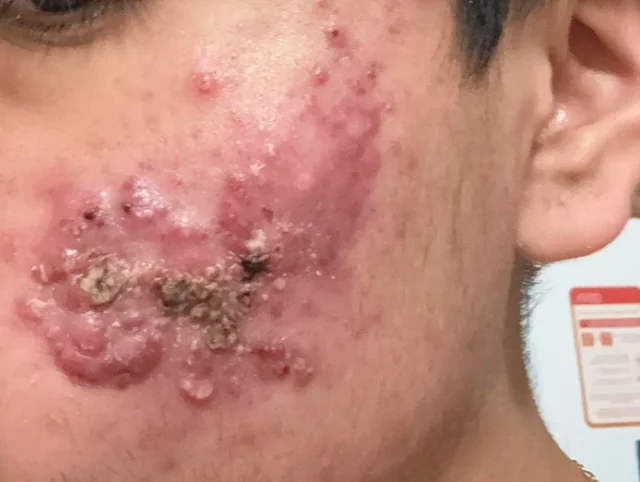- The types of acne are blackheads, whiteheads, pustules, papules, nodules, and cysts.
- A papule is a raised lesion that can fill with pus and become a pustule.
- Though you can treat most types of acne with storebought remedies, cysts may require injections.
But not all pimples are the same. For example, a blackhead is different from a pustule which is different from a nodule. And these differences are important for figuring out the right treatment.
1. Blackheads
Blackheads, aka open comedones, get their name from the fact that they appear as a black spec on your skin.
Blackheads start out similar to any other pimple: Skin debris (aka keratin) mixes with sebum — the natural oil in your skin — clogging your pores.
What makes blackheads different is that the pore is open to the air. Oxygen from the air triggers a chemical reaction — oxidation — with the material in your pore, causing it to turn black, says board-certified dermatologist with
How to treat them:
The best solution for blackheads is to wash your face with a beta hydroxy acid (BHA) such as , which deeply penetrates the pores and can unclog them, McMahan says.
Additionally, you can try over-the-counter retinol such board-certified dermatologist and Clinical Professor of Dermatology at the University of Minnesota Medical School.
is a form of vitamin A that works by increasing skin cell turnover, breaking up the cells that form the clogs and reducing future clogged pores, says Crutchfield.
2. Whiteheads
Whiteheads, aka closed comedones, are similar to blackheads except instead of being open to the air, the pore is closed off by a layer of skin, says McMahan.
How to treat them:
While it’s tempting to try to pop whiteheads, you should avoid this so that you don’t
Similar to blackheads, the best treatment is to wash your face with a BHA such as salicylic acid and use oil-free non-comedogenic products. Again, you can also try over-the-counter retinol, Crutchfield says, for control of both blackheads and whiteheads.
3. Pustules
Pustules contain fluid or pus, and they show up as large white bumps surrounded by red, inflamed skin. Most commonly, bacterial growth in clogged follicles causes pustules, McMahan says.
How to treat them:
Smaller pustules may go away without treatment, but you can also use topical benzoyl peroxide or sulfur-based face washes, McMahan says. Both of these can decrease inflammation and kill bacteria that are growing in the follicle and on the skin’s surface.
In more severe cases, Crutchfield says topical or oral antibiotics may be prescribed by a dermatologist. These include (oral) and (topical).
4. Papules
Papules are solid, raised lesions usually less than one centimeter in diameter, McMahan says.
They may be a variety of different shapes, colors, and sizes. While they start out solid, after a few days and become a pustule.
How to treat them:
The key is to avoid irritation to the area, says McMahan. Don’t scrub your skin and be gentle when you cleanse with warm water. You can wash your face with a
McMahan also recommends that you avoid putting makeup on papules, so the affected area can get as much air as possible.
5. Nodules
A nodule develops when the pores deeper down in the skin are plugged by dead skin cells and oil, says Crutchfield. This results in a large, deep lesion that may be visible on the surface if it’s inflamed. If they continue to grow larger, they can become a nodule cyst, Crutchfield says, which is usually painful.
How to treat them:
Nodules typically need stronger treatment than what over-the-counter products provide. Oral antibiotics such as minocycline or oral retinoids such as , commonly called Accutane, may help, says Crutchfield.
Another option is directly into the nodule, which can quickly reduce inflammation and pain.
6. Cysts
Cystic acne is considered the most serious type of acne, McMahan says. Similar to nodules, cysts are caused by clogged pores beneath the surface of the skin. They contain fluid or pus, and they may appear large, red, and are typically painful.
How to treat them:
Like nodules, over-the-counter treatments aren’t enough to treat cysts. It’s important to get the proper treatment from a dermatologist to prevent scarring from these cysts. Crutchfield says prescription options include isotretinoin and antibiotics. Steroid injections are an option, as well.
